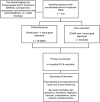Outcomes following extended thoracic endovascular aortic repair for Type B aortic dissection from the global registry for endovascular aortic treatment
- PMID: 40674576
- PMCID: PMC12282756
- DOI: 10.1093/icvts/ivaf156
Outcomes following extended thoracic endovascular aortic repair for Type B aortic dissection from the global registry for endovascular aortic treatment
Abstract
Objectives: This study evaluated the short- to longer-term safety and efficacy of extended thoracic endovascular aortic repair for Type B aortic dissection.
Methods: We identified acute and subacute Type B dissection between 2010 and 2016 in the Global Registry for Endovascular Aortic Treatment. We stratified the population based on treatment extent: 'non-extended' (1 stent graft deployed), 'extended' (>1 stent graft deployed). Our primary outcomes were in-hospital spinal cord ischaemia and mortality. Secondarily, we evaluated procedure-related complications (endoleak, migration, fracture, compression, reinterventions), sac dynamics, rupture, and all-cause mortality at 1 and 5 years. Sensitivity analysis was performed in patients without prior aortic procedures.
Results: Of 170 procedures, 78 (46%) were extended (median 2 [range 2-5] stent-grafts). Extended and non-extended treatment had similar rates of complicated presentations (53% vs 64%; P = 0.13). Compared with non-extended treatment, extended treatment had similar in-hospital rates of spinal cord ischaemia (2.6% vs 2.2%; P = 1) and mortality (2.6% vs 2.2%, P = 1). Additionally, extended treatment had not statistically different sac expansion rates, (1 year: 14% vs 23%, P =0.80; 5 years: 16% vs 32%, P=0.29) and rupture risk (1 year: 1.3% vs 3.3%, P = 0.63), similar procedure-related complications (endoleak, migration, fracture, compression, reinterventions; all P > 0.05) and all-cause mortality (1 year: 10% vs 7.6%, P=0.54; 5 years: 19% vs 21%, P=0.82). All outcomes remained similar on sensitivity analysis.
Conclusions: Our findings suggest that extended treatment for Type B aortic dissection may be associated with similar procedure-related risks and complications. Future larger studies are needed to define who might benefit from an extended treatment and further optimize patient-specific treatment for aortic dissection.
Keywords: GREAT registry; Type B aortic dissection; long-term outcomes; sac dynamics; spinal cord ischaemia; thoracic endovascular aortic repair.
© The Author(s) 2025. Published by Oxford University Press on behalf of the European Association for Cardio-Thoracic Surgery.
Conflict of interest statement
S.T. and D.R.G. are principal investigators of the GREAT; S.T. is a consultant for Terumo Aortic, Medtronic Inc., and W.L. Gore; D.R.G. is a consultant for W.L. Gore and Medtronic Inc., provides research support for W.L. Gore, Medtronic Inc. and Silk Road, and is on the Advisory Board of W.L. Gore.
Figures




References
-
- Riambau V, Böckler D, Brunkwall J et al. Editor’s Choice—management of descending thoracic aorta diseases: clinical practice guidelines of the European Society for Vascular Surgery (ESVS). Eur J Vasc Endovasc Surg Off J Eur Soc Vasc Surg 2017;53:4–52. - PubMed
-
- Isselbacher EM, Preventza O, Hamilton Black J III, et al. 2022 ACC/AHA Guideline for the Diagnosis and Management of Aortic Disease: a Report of the American Heart Association/American College of Cardiology Joint Committee on Clinical Practice Guidelines. Circulation 2022;146:e334–482. - PMC - PubMed
-
- Upchurch GR, Escobar GA, Azizzadeh A et al. Society for vascular surgery clinical practice guidelines of thoracic endovascular aortic repair for descending thoracic aortic aneurysms. J Vasc Surg 2021;73:55S–83S. http://www.ncbi.nlm.nih.gov/pubmed/32628988 - PubMed
-
- Spinelli D, Weaver FA, Azizzadeh A et al. Endovascular treatment of complicated versus uncomplicated acute type B aortic dissection. J Thorac Cardiovasc Surg 2023;165:4–13.e1. - PubMed
-
- Veranyan N, Magee G, Kuo E et al. Impact of aortic coverage length on thoracic and abdominal aortic remodeling following TEVAR for type B dissections. SCVS Annu Symp 2019. https://symposium.scvs.org/abstracts/2019/MP57.cgi
Publication types
MeSH terms
Grants and funding
LinkOut - more resources
Full Text Sources

